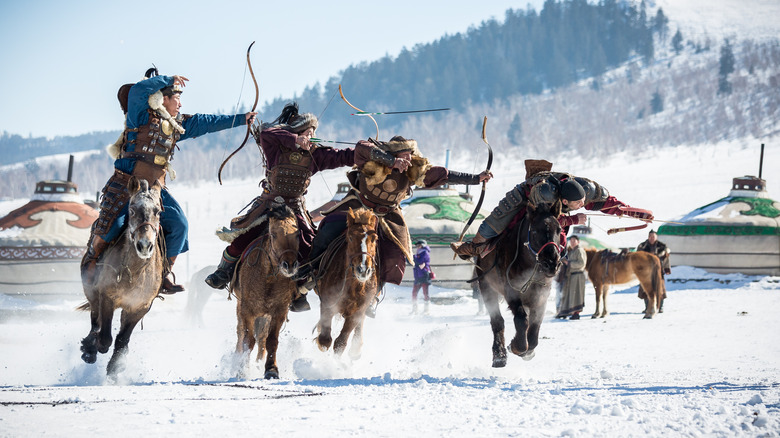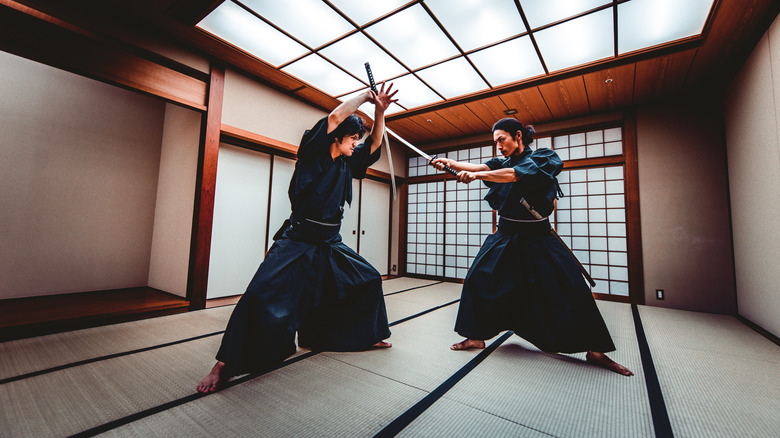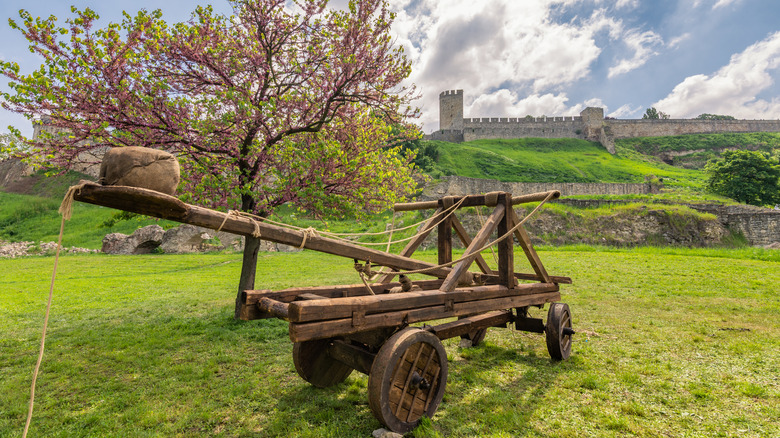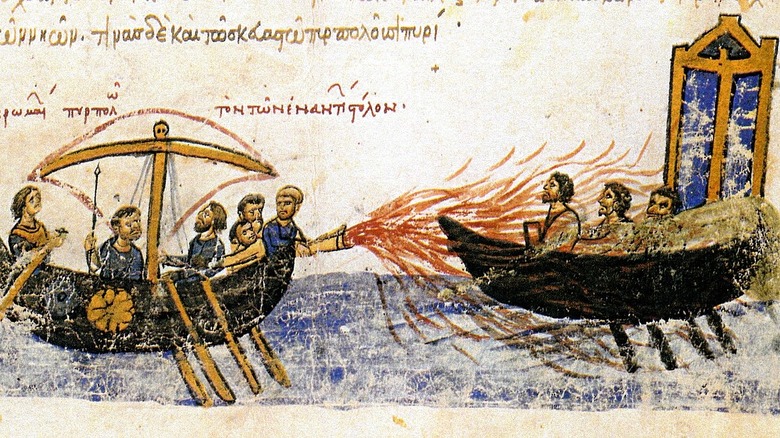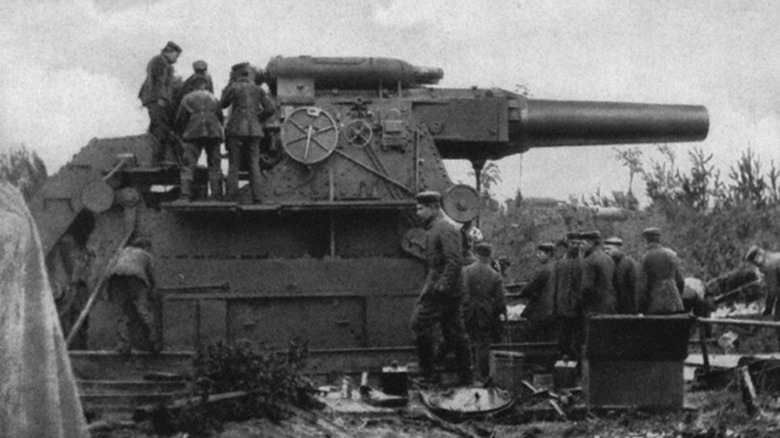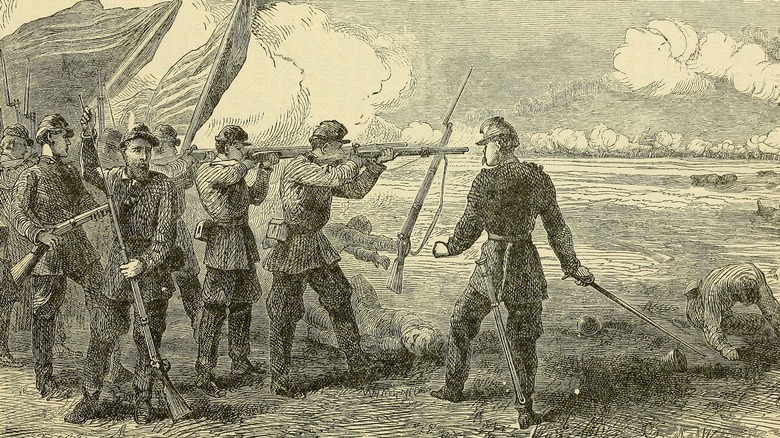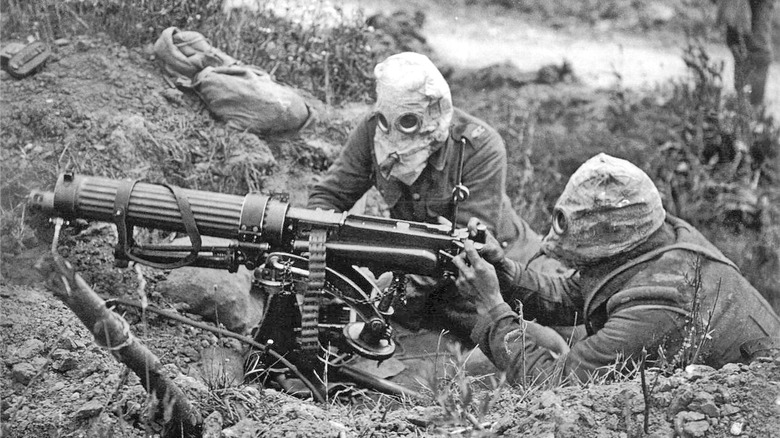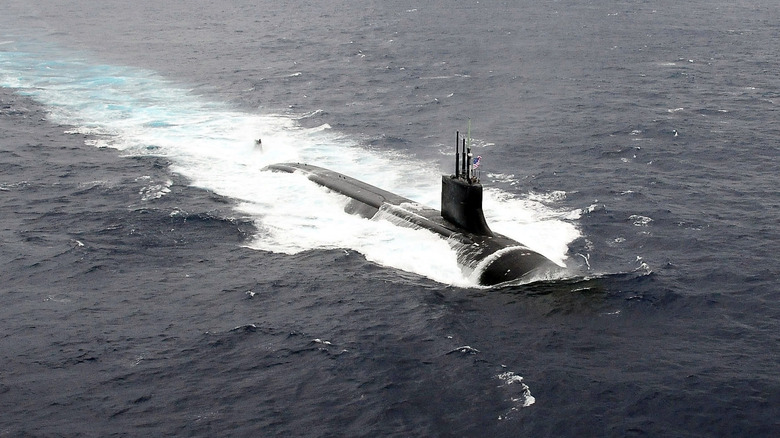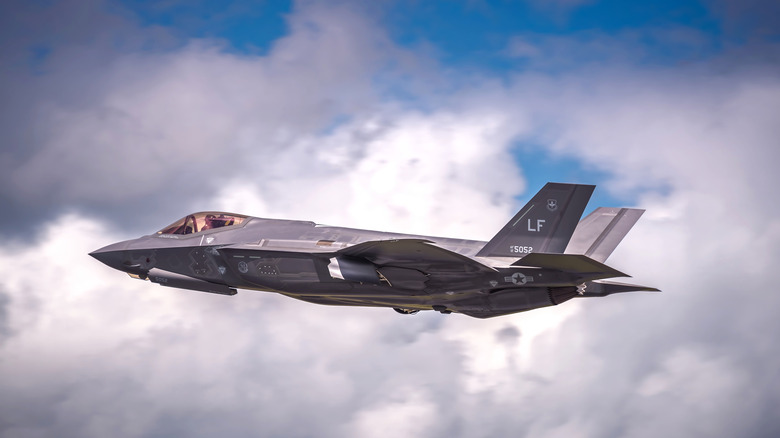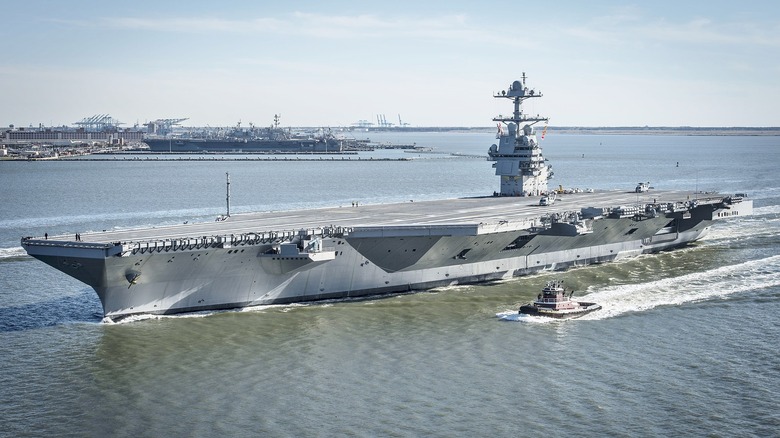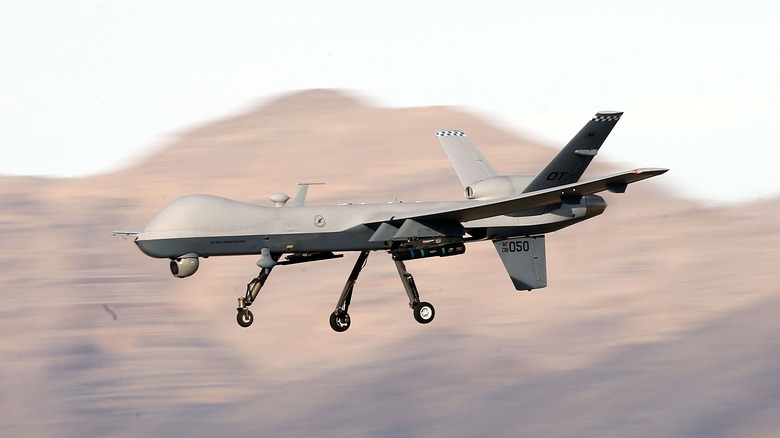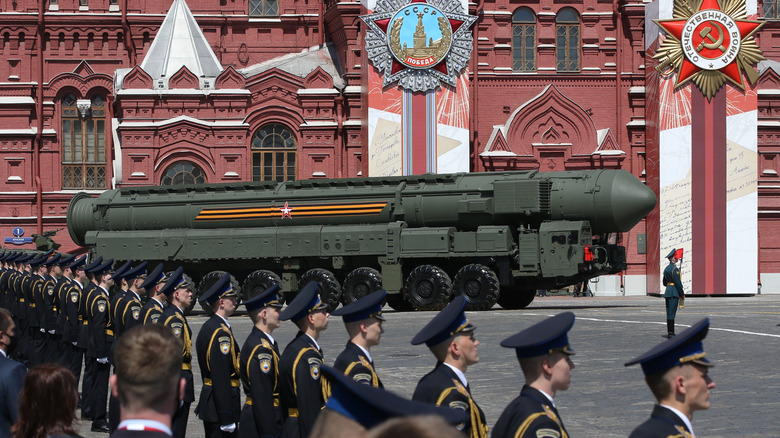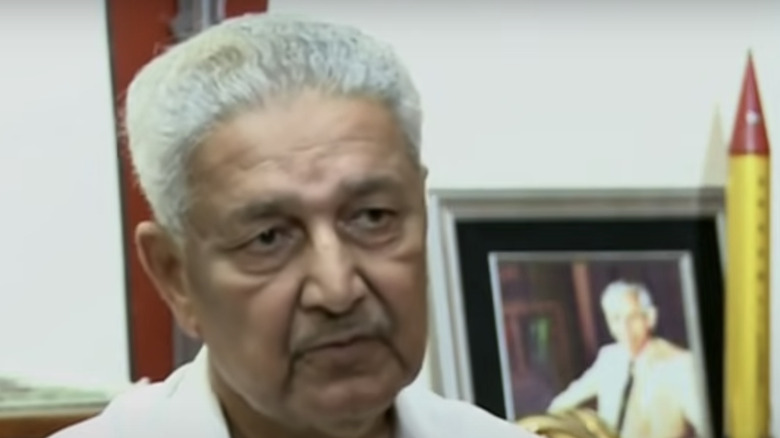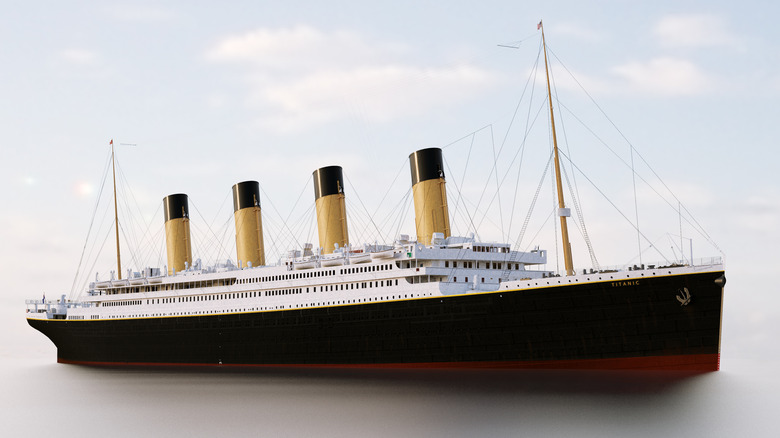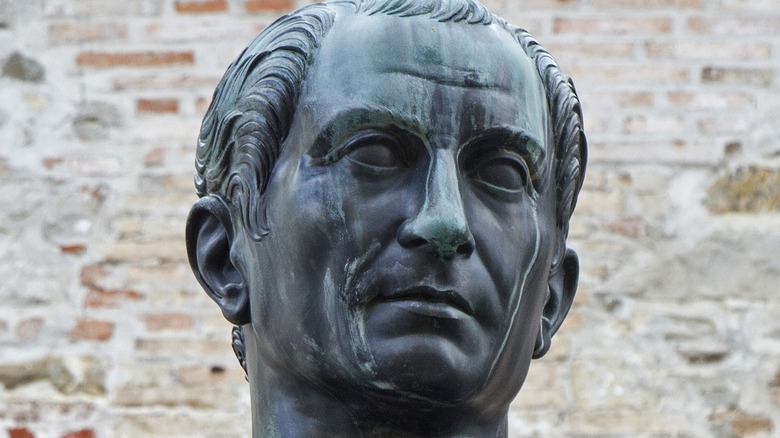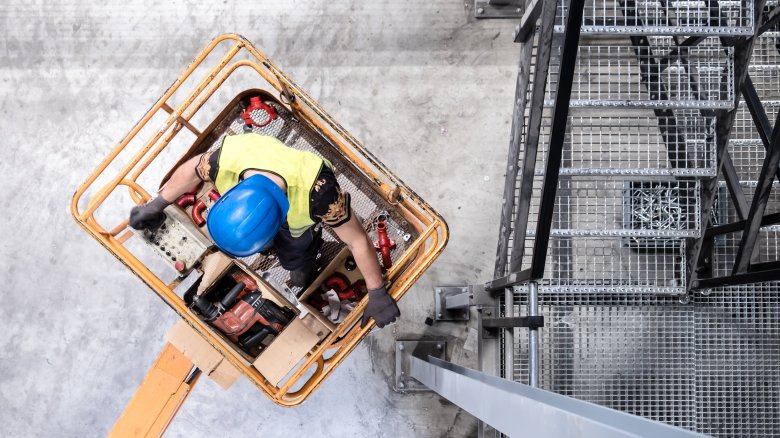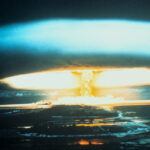
Most Dangerous Weapons In The World
Weapons have been with humanity from its earliest days. As Britannica notes, it seems that with each passing century, humans find newer and more efficient ways to kill each other. In fact, when looking at the history of weapons, the rate of technological change has sped up so much since the 19th century that it is frightening to consider what armament we may have at our disposal 100 years from now.
This article will explore some of the most dangerous weapons in the world — ever. The operative word is ever. The main criteria are how the weapons rocked human history compared to what came before them, and what kind of threat the weapons posed or pose. This list is by no means exhaustive since humans excel in finding new ways to fight. So while there will be no Cobra Weather Dominators operated by Destro, rest assured that there are plenty of scary weapons out there that are even more dangerous.
Bows and arrows
The bow and arrow is one of the most ancient weapons. Britannica estimates that bows and arrows were in use as early as 61,000 years ago in South Africa. The bow and arrow is also one of the most dangerous and impactful weapons in humanity’s history. The bow allowed humans to launch lethal missiles at greater distances and with more power, which made it immediately useful for both hunting and warfare — particularly the latter. According to Vic Hurley’s “Arrows Against Steel,” the chief civilizations to capitalize on the technology of the bow and arrow were those in Asia, and it allowed them to build immense empires.
The best example of just how dangerous the bow was is in the formation of the immense Mongol Empire, which was founded by the notorious Genghis Khan. The Mongols’ combination of new types of composite recurve bows, superior horsemanship, and ruthless tactics created the largest land empire in history. And while Europe generally eschewed bow and arrow use, when innovative models were used, they were game-changers. One example of this is the use of the longbow against the French in the Hundred Years’ War. As pointed out in “The Longbow,” these weapons showed their superiority to traditional heavy armor and lances.
Swords
The sword represented a massive shift in military technology and the power of weapons. As explained by the Warfare History Network, the sword was invented around 1000 B.C. during the Bronze Age, first using the soft metal of bronze for the blade. This decision puzzled scholars, who could not figure out how such weapons could be effective. However, a 2020 scientific study reported by Smithsonian showed just how deadly these weapons could be in the hands of a skilled warrior.
Unlike weapons like spears or bows, which could be used for hunting, swords were created solely to kill people. Swords evolved after the Bronze Age with the implementation of iron and then later steel, and they varied in the ways they were used. According to World History Encyclopedia, the Romans famously built their military power using a stabbing short sword called the gladius Hispaniensis. As noted by the World History Encyclopedia, the advent of the weapon took place while the samurai of Japan used the famed katana as a slashing weapon.
Other cultures — such as the Swiss and Germans from the 14th to 17th centuries — adopted ever-larger swords with blades that grew up to 55 inches in length. Per Britannica, some adopted long, thin rapiers after body armor was abandoned. It was this versatility and adaptability that made the sword a dangerous weapon for the ages. Although it was largely abandoned in the 20th century after the invention of repeating firearms, it was still used in sporadic engagements.
Catapults
Nothing signifies ancient and medieval siege warfare like the catapult. As noted by Britannica, catapults are typically pictured as engines that can hurl large rocks long distances. However, the definition is actually much broader and refers to all instruments of war that hurl objects with distance and force. This includes engines such as the Greek and Roman ballista — which shot out darts and arrows — and the powerful medieval trebuchet.
Until the advent of gunpowder, catapults were the most powerful weapon in a military’s arsenal. They were used to batter down walls, hurl disease-infested corpses among citizenry, and launch flaming projectiles. Per The New York Times: “They were prized assets in an arms race and had profound effects on affairs of state.” Most catapults worked by releasing tension either through bent wooden beams or torsion created by twisted cords.
The trebuchet was an exception to this rule and worked using gravity and counterweights. As the World History Encyclopedia explains, trebuchets became so valuable that they were personalized with nicknames like “Bad Neighbor” and “the Bull.” These grew increasingly huge, and by the 14th century, some of these machines were using counterweights of almost 30,000 pounds. Notably, one of King Edward I’s trebuchets took three months of work for 54 carpenters. But like many old weapons, they eventually became displaced by gunpowder armaments.
Greek fire
One of the most intriguing weapons in history and surely the most dangerous was Greek fire. As detailed by the World History Encyclopedia, Greek fire was an incendiary weapon invented in A.D. 668 by Kallinikos, who was a Greek refugee from Byzantine Syria after the Muslims’ conquest. This weapon was first used by the Byzantines at sea where it was pressurized and sprayed through nozzles at enemy vessels in ship-to-ship combat. And given that it burned on water, the weapon was an absolute terror. Indeed, Greek fire arguably saved the Byzantine Empire from Muslim conquest. The Byzantines later innovated Greek fire for use on land — such as in grenades — and the weapon stretched out the lifespan of the Byzantine Empire by centuries.
Given the incredible effectiveness of the weapon, “Secrecy, Technology, and War” notes that the chemical formula to manufacture Greek fire was top secret. Some have speculated that there was naphtha or a light petroleum in the formula. In addition, accounts of explosive sounds when it was deployed make some suppose that saltpeter was present, making Greek fire possibly one of the earliest military uses of gunpowder. Although the jury is still out on what Greek fire was, the Byzantines kept their state secret secure for seven centuries, thus building up the legend of what at the time seemed to be a magical weapon of destruction.
Cannons
Cannons, and by extension the use of gunpowder, changed the face of warfare forever. According to Live Science, gunpowder was invented around A.D. 850 by Chinese alchemists who were trying to develop life-extending potions through the use of saltpeter. Indeed, mixing this compound with sulfur and charcoal produced explosive gunpowder, which was first used by the Sung Dynasty against the Mongols in the form of flying arrows. But after the development of cannons, gunpowder became even more important. Although there may have been earlier cases, Wired reports that the first confirmed use of cannons was in 1346 during the Battle of Crécy, where they were defeated by the English longbow. Cannons continued to develop both as large arms and small handheld cannons, which would morph into muskets and guns.
Nearly a century after Crécy, cannons had evolved to the point where they made their first dramatic impression on world events. Per “Turkish Bombard,” the Ottoman Empire under Mehmed II was able to build its domain and conquer the seemingly impregnable Constantinople through the use of the cannon. Cannons on land — and later on ships at sea — would be widely adopted and are still used by militaries in the present day.
Rifles
Rifling technology is a subtle improvement in firearm technology that makes dangerous weapons even more dangerous. So what is this improvement? Gun barrels are smooth-bore or rifled. As described by Britannica, the former have smooth interiors, while the latter have spiral shallow grooves that spin the projectile and give it far better accuracy.
While rifled firearms were around as early as the 15th century, they were not widely adopted since muskets at that time were loaded through the muzzle of the barrel. This was a lengthy process made more difficult in early rifles because the ball had to fit tightly with the grooves. But as reported by History, in 1849, the French army officer Claude-Etienne Minié invented a lengthened bullet called the Minié ball that expanded when fired. This expansion tightened the bullet around the grooves and lead to increased accuracy. Most firearms of today use rifling technology, and further innovations — such as the development of breech-loading rifles and repeating action — made rifles even more dangerous. The staggering 200,000 dead and over 400,000 wounded in the American Civil War is a testament to the dangers of this weapon.
Machine guns
Without a doubt, the introduction of machine guns in the late 19th and early 20th century changed warfare by introducing industrial means to kill people en masse. As told by Norwich University, fully automatic machine guns were developed by Hiram S. Maxim in 1884. However, as noted by “The Development of the Machine Gun and Its Impact on the Great War,” these were not widely used until the Russo-Japanese War of 1904 to 1905. This war demonstrated that machine guns could kill lots of people in larger offensive forces and force soldiers to dig trenches.
The deadliness of this weapon was on full display during World War I. Machine guns of this era, while heavy at 136.5 pounds, could spit out up to 600 rounds per minute. Is it any wonder that Britannica reports this war saw 8.5 million soldiers dead? Indeed, the Battle of the Somme saw the British lose over 57,000 soldiers alone. In fact, the machine gun so dominated the war that in 1917, German machine gunners used 90% of the country’s small arms ammunition. Machine guns are in use today and are far lighter and more deadly thanks to firing more rounds per minute. Despite technological innovations in other munitions, the machine gun is still one of the world’s most dangerous weapons.
Submarines
Vessels that roam beneath the waves had long been a dream of humankind. According to History, the earliest types of submarine vessels were built in the 17th century, but the technology to make them dangerous weapons of war was not fully realized until the early 20th century. According to “The Submarine in Naval Warfare,” submarines began to serve in navies in 1901 but were seen mainly as novelties. However, their effectiveness was first demonstrated during World War I. In particular, the German Empire put them to good use, sinking so much British tonnage that Britain was nearly knocked out of the war, the Imperial War Museum claims. The weapons also contributed greatly to both Axis and Allied efforts in World War II.
Since the war, submarines have grown even more dangerous. Nuclear models can run indefinitely under the sea and have the ability to launch nuclear missiles. As described by the Federation of American Scientists, the latest American Seawolf attack submarines are massive weapons that are 353 feet long and able to make 35 knots while submerged. And as with submarines of the past, their stealth and ability to surprise an enemy with no less than a nuclear weapon make them truly some of the world’s most dangerous modern weapons.
Aircraft
One of the most important innovations of the early 20th century was the invention of the airplane by the Wright brothers in 1903. Indeed, the pair had realized the eternal dream of humankind to achieve powered flight. However, within a few years, this invention was transformed into a weapon of war. The airplane made its debut as a weapon during World War I, where it was used for reconnaissance, dogfighting, and some ground attacks. At the conclusion of the war, engineers further developed aviation technology that made aircraft decisive weapons during World War II, per “The World’s Greatest Military Aircraft.” Consider the Battle of Britain, which saw Germany conduct an air bombing campaign against the United Kingdom in order to soften it for invasion. This operation failed in part because of the tenacity of British Spitfires. And as the war progressed, planes grew larger and more powerful. Per the Imperial War Museum, the B-29 Superfortress that dropped the atomic bombs on Japan was the largest airplane of the war.
After the war, airpower continued to develop through the innovation of jet engines, air-to-air missiles, and stealth technology. For example, an American F-35-C Lightning II has characteristics that would boggle the Wright brothers. According to the U.S. Naval Academy, this stealth fighter can achieve speeds well above sound and integrates the latest technologies to immerse pilots in situational awareness. For their range and deadliness, airplanes may be the most dangerous conventional weapons in today’s military arsenal.
Aircraft carriers
There is no more powerful weapon at sea today than the aircraft carrier. As maintained by “Military Innovation and Carrier Aviation,” these vessels displaced battleships during World War II as the preeminent fleet ship. According to Britannica, the reason for this displacement is straightforward. While a battleship had an attack range of about 20 miles, a carrier had a range of about 200 miles. Ultimately, the carrier is essentially a mobile, floating airbase, so the aircraft it carries can be flexibly deployed throughout the world.
The U.S. Navy’s latest design, the U.S.S. Gerald R. Ford, is an example of just how dangerous these ships are. According to All Hands, the 100,000-tonne Ford is 1,092 feet long and contains over 75 of the latest aircraft. Since the ship is powered by two nuclear reactors, it virtually never has to be refueled. To fully operate the carrier, the U.S. Navy requires over 4,500 crew. These ships are also incredibly hard to sink. As reported by Business Insider, in 2005, the U.S. Navy decided to test to see how hard it was to sink a carrier. Using the decommissioned U.S.S. America as a guinea pig, the military subjected the carrier to four weeks of bombardment before it sank. At the end of the day, this durability is due to their immense size as floating citadels of steel.
Drones
Unmanned Aerial Vehicles (UAVs) are more commonly known as drones. And though Britannica notes that drones should refer to the smaller aircraft of this class, for our purposes, we’ll call a drone any unmanned aircraft that can be remotely controlled and used as a weapon.
Drones were in use as targets as early as World War II, but they did not start to come into prominence as weapons until the 21st century. The benefit of using a drone as a weapon is that the wielder may be half a world away, remotely controlling the aircraft as it performs reconnaissance or attack strikes. One of the largest, the Reaper, is propelled by a turboprop and can carry some 3,000 pounds of ordnance. In 2020, one well-known drone strike killed Iranian General Qassim Suleimani at the Baghdad airport, as reported by The New York Times. Today, these devices are seen as important anti-terrorist weapons.
Of course, the use of drones brings up ethical and practical concerns. Political scientist and professor Stefan Wolff of the University of Birmingham offered the crux of the debate: “They [drones] infuriate local populations and governments, alienate potential allies, and serve as recruiting agents for insurgent movements and terrorist networks. The counter-argument is about drones being effective in proactively limiting insurgent and terrorist capabilities, minimizing civilian casualties and collateral damage, and reducing the risk to ‘our own’ troops, while being more flexible and cost-effective to deploy. Regardless of where one stands in this debate, drones are here to stay.”
Nuclear Weapons
No list of the world’s most dangerous weapons would be complete without nuclear weapons. In the early 20th century, physicists theorized that by splitting the nuclei of atoms, a chain reaction called nuclear fission would occur that could release an incredible amount of energy. Nuclear weapons were first developed as an American secret military program called the Manhattan Project during World War II. The first successful test of an atomic bomb occurred in New Mexico in July 1945, and the first — and to date only — use of these weapons occurred the next month against Hiroshima and Nagasaki in Japan, thus ending World War II.
National Geographic explains how this development set the stage for all of post-war history. It set off the Cold War with the Soviet Union, of which one significant element was the continual build-up of nuclear arsenals. Soon enough, enough nuclear weapons had been constructed to kill the human population many times over — the number of nuclear weapons topped out at 70,300 in 1986. Since then, arms have been reduced, and in 2020, there were “only” 13,410 nuclear weapons in the world. As the United Nations Office for Disarmament Affairs wrote: “Nuclear weapons are the most dangerous weapons on earth. One can destroy a whole city, potentially killing millions, and jeopardizing the natural environment and lives of future generations through its long-term catastrophic effects. The dangers from such weapons arise from their very existence.”

The Dramatic Way The Printing Press Changed History Forever
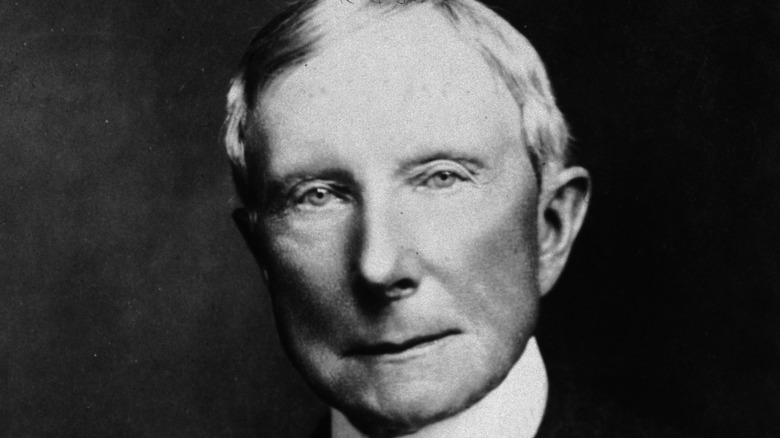
The Truth About The Assassination Attempt On John D. Rockefeller
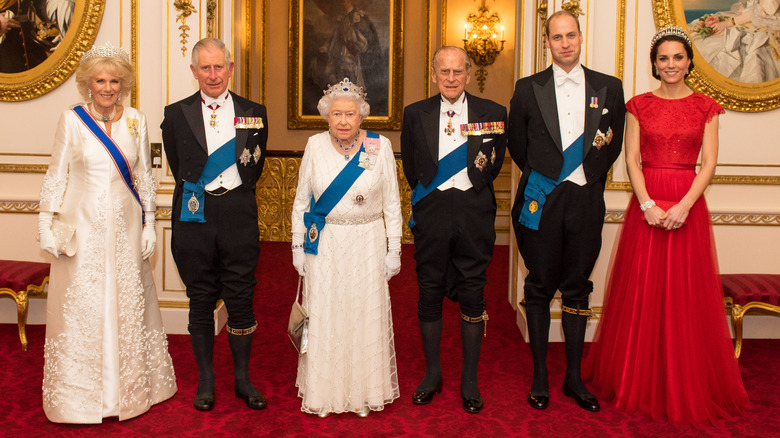
Here's What Would Happen If Britain Got Rid Of Their Monarchy

John Hinckley Jr: The Reason Ronald Reagan's Attempted Assassin Was Found Not Guilty

The Strange Case Of Billy Milligan And His 24 Personalities

What We Know About The Fire Department Chaplain Who Was Among The First To Die On 9/11

The Wild True Story Of Con Artist Belle Gibson

The Real Reason Paul Rodgers Left Queen

The Tragic Death Of Jean Harlow

People Who Died Attempting A World Record
